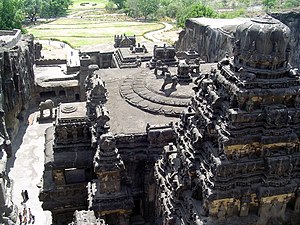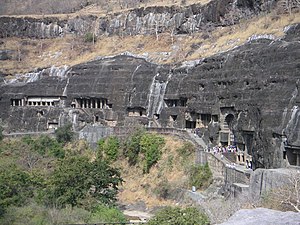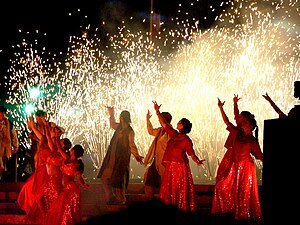Cultural activities of Maharashtra
Religions and Social Activities in Maharashtra are well diverse democracy and all mixed cultures as like the rest of India. Maharashtra has a history of more than one thousand years in religions, social festivals, and diverse cultures.
Popular Festivals in State[edit]

Lord Ganesha's devotion is celebrated by Ganesh Chaturthi (Ganesh's birthday) in August–September of every year.[1] Lalbaugcha Raja, Shri Siddhivinayak Temple, Shri Ashtavinayaka's are the major holy places for Maharashtrians.
In modern times Nisargadatta Maharaj, a Shudra , and bidi-seller became a Hindu saint of major influence in India. Popular forms of God are Shiva, Krishna , and Ganesha. Lord Shiva's devotion is celebrated by taking part in Maha Shivaratri (Night of Shiva) festival. In modern times, the Elephanta Island in Mumbai, Lord's Shiva island in local mythology, originated the Elephant Festival.
Lord Krishna's devotions are celebrated in the statewide Gokul Ashtami (or Krishna Janmashtami, Krishna's birthday) whereby many devotees fast on an entire day until midnight. The Dahi-Handi (Matki-fod) is also observed on this day in many places.[2] Lord Krishna's devotion is also celebrated at Kaartik Aamawasya (or Diwali) and at Narak Chaturdashi as returning of Lord Shri Rama.
The other festivals celebrated on a large scale are Vijayadashami or Dasara (Marathi: दसरा), Navaratri, Holi, Diwali, Eid (Ramzan Eid). Simollanghan is a ritual performed on Dasara or Vijaya Dashami day in Maharashtra. Simollanghan is crossing the border or frontier of a village or a place. In ancient times, kings used to cross the frontier of their kingdom to fight against their rivals or neighbor kingdoms. They used to perform Ayudha Puja on Dasara and begin the war season. On Dasara, people cross the borders of their places (Simollangan) and collect the leaves of Apta tree (आपट्याची पाने, āpţyācī pānē) and exchange among their friends and relatives as gold (सोने म्हणून आपट्याची पाने देतात, sōnē mhaṇūn āpaţyācī pānē dētāt).[3] People worship Shami tree and its leaves (शमीची पाने, śamīcī pānē) on this day.[citation needed]
Hindus in Maharashtra follow the Shalivahana Saka era calendar. Gudi Padwa, Diwali, Rangapanchami, Gokulashtami , and Ganeshotsav are some of the festivals that are celebrated in Maharashtra. Ganeshotsav is one of the biggest festivals of Maharashtra which is celebrated with much reverence and festivity throughout the state and has since some time become popular all over the country. The festival which continues over ten days is in honor of Ganesha, the god of learning and knowledge. A large number of people walk hundreds of kilometers to Pandharpur for the annual pilgrimage in the month of Aashadh.
Deities and Saints (Sant) of Maharashtra[edit]
Every Marathi Hindu family has its own family patron deity or the Kuladaivat.[4] This deity is common to a lineage or a clan of several families who are connected to each other through a common ancestor.[4][5] The Khandoba of Jejuri is an example of a Kuladaivat to several castes ranging from Brahmins to Dalits.[6] The practice of worshiping local or territorial deities as Kuladaivats began in the period of the Yadava dynasty.[5] Other family deities of the people of Maharashtra are Bhavani of Tuljapur, Mahalaxmi of Kolhapur, Mahalaxmi of Amravati, Renuka of Mahur, Parashuram in Konkan, Saptashringi on Saptashringa hill at Vani in Nasik district. Despite being the most popular deity of Hindu Marathi people, very few families regard Vitthal or other popular Avatars of Vishnu such as Rama or Krishna as their Kuldaivat, with Balaji being an exception.
Marathi Hindus revere Bhakti saints of all castes, such as Dnyaneshwar (Brahmin-kulkarni's) Tukaram (Moray Maratha-Kunbi), Namdev (Shimpi), Chokhamela (Mahar) and Savata Mali (Mali). There were several other Dalit saints of Maharashtra. They are Sant Banka Mahar, Sant Bhagu, Sant Damaji panth, Sant Kanhopatra, Sant Karmamelam, Sant Nirmala, Sant Sadna, Sant Sakhubai, Sant Satyakam Jabali, Sant Soyarabai. Other important devotees are Namdev Mahar, a devotee of Shirdi Sai Baba, who lived in Kharagpur[7] and Bhagubai, the wife of Namdev Mahar, a devotee of Sai.
Maharashtra is also the home and birthplace for the very popular saints of the late 19th and early 20th century such as Shri "Sai Baba" at Shirdi in Ahmednagar district, Shri "Gajanan Maharaj" at Shegaon in Buldhana district and "Shri Swami Samartha" at Akkalkot in Solapur district. Shri Shirdi Sai Baba devasthan is the second richest in the country [8][9] after Lord Tirupati Devasthanams at Tirumala, Andhra Pradesh.[10]
Ethnic groups[edit]
The Marathi people are the majority throughout most of the areas of the state. While there are other people who speak different languages, including Hindi, Kannada, Gujarati, and Marwari.
Culture[edit]



Marathi is the official language of Maharashtra. Maharashtrians take great pride in their language and history, particularly the Maratha Empire, its founder Chatrapati Shivaji Maharaj is considered a folk hero across India. About 80% of Maharashtrians are Hindu, and there are significant Muslim, Christian , and Buddhist minorities. There are many temples in Maharashtra some of them being hundreds of years old. These temples are constructed in a fusion of architectural styles borrowed from North and South India. The temples also blend themes from Hindu, Buddhist , and Jain cultures. A National Geographic[11] edition reads, "The flow between faiths was such that for hundreds of years, almost all Buddhist temples, including the ones at Ajanta, were built under the rule and patronage of Hindu kings." The temple of Vitthal at Pandharpur is the most important temple for the Varkari sect. Other important religious places are the Ashtavinayaka temples of Lord Ganesha, Bhimashankar which is one of the Jyotirling (12 important Shiva temples). Ajanta and Ellora Caves near Aurangabad as well as Elephanta Caves near Mumbai are UNESCO World Heritage Sites and famous tourist attractions. Mughal architecture can be seen is the tomb of the wife of Aurangzeb called Bibi Ka Maqbara located at Aurangabad.
In 1708, the year following the death of Aurangzeb, Guru Gobind Singh the tenth spiritual leader of the Sikhs came over to Nanded, his permanent abode. He proclaimed himself the last living Guru and established the Guru Granth Sahib as the eternal Guru of the Sikhs. This elevates the reverence of Granth to that of a living Guru. A monument has been constructed at the place where he breathed his last. Maharaja Ranjit Singh's endowment saw the construction of a beautiful Gurudwara at Nanded around 1835 AD. The Gurudwara features an imposing golden dome with intricate carvings. It is known as Shri Huzur Abchalnagar Sachkhand Gurudwara.
Maharashtra has a large number of hills, land and sea forts. Forts have played an important role in the history of Maharashtra since the time of the Peshwas. Some of the important forts in Maharashtra are Raigad, Vijaydurg, Pratapgad, Sinhagad. The Majority of the forts in Maharashtra are found along the coastal region of Konkan.
Maharashtra, like other states of India, has its own folk music. The folk music viz. Gondhal Lavani, Bharud and Powada are popular especially in rural areas, while the common forms of music from the Hindi and Marathi film industry are favoured in urban areas.
Marathi Literature[edit]
The earliest instances of Marathi literature is by Sant Dnyaneshwar with his Bhawarthadeepika (popularly known as Jnyaneshwari). The compositions written during this period are spiritually inclined. The other compositions are by Sant Tukaram, Sant Namdev, and Sant Gora Kumbhar. The compositions are mostly in poetic form, which are called bhajans. These bhajans by saints are popular and part of day-to-day life. The modern Marathi literature has been enriched by famous poets and authors like P. L. Deshpande, Kusumagraj, Prahlad Keshav Atre , and Vyankatesh Madgulkar. This literature has been passed on to the next generations through the medium of large numbers of books that are published every year in Marathi.
Cuisines[edit]
The cuisine of Maharashtra varies according to the region of Maharashtra. The people of the Konkan region have a chiefly rice-based diet with fish being a major component, due to the close proximity to the sea. In eastern Maharashtra, the diet is based more on wheat, jowar , and bajra. Puran Poli, Bakarwadi, plain simple Varan Bhat (a dish cooked with plain rice and curry), and Modak are a few dishes to name. Chicken and mutton are also widely used for a variety of cuisines. Kolhapuri Mutton is a dish famous for its peculiar spicy nature.
Clothes[edit]
Women traditionally wear a nine-yard or five-yard sari and men a dhoti or pajama with a shirt. This, however, is changing with women in urban Maharashtra wearing Punjabi dresses, consisting of a Salwar and a Kurta while men wear trousers and a shirt.
Marathi and Hindi Film Industry[edit]

The world-famous film industry Bollywood is in Maharashtra, located in the economic capital of India, Mumbai. The Marathi film industry was once placed in Kolhapur but now is spread out through Mumbai too. The pioneer of the Indian movie industry, Bharat Ratna Shri Dadasaheb Phalke, producer & director V. Shantaram, B.R. Chopra, Shakti Samanta, Raj Kapoor, form a few names of the Hindi film fraternity, while writer, director, and actor P. L. Deshpande, actor Ashok Saraf, actor Laxmikant Berde, actor & producer, Sachin Pilgaonkar, Mahesh Kothare belong to the Marathi film industry. The early period of Marathi theatre was dominated by playwrights like Kolhatkar, Khadilkar, Deval, Gadkari , and Kirloskar who enriched the Marathi theatre for about half a century with excellent musical plays known as Sangeet Naatak. The genre of music used in such plays is known as Natyasangeet. It is during this era of the Marathi theatre that great singer-actors like Bal Gandharva, Keshavrao Bhosle, Bhaurao Kolhatkar and Deenanath Mangeshkar thrived.
Some of the popular Marathi television channels are Star Majha, Zee Talkies, Zee Chovis Taas, Mi Marathi, DD Sahyadri, Zee Marathi, ETV Marathi, and Saam Marathi which host shows ranging from soap operas, cooking , and travel to political satire and game shows.
Sports[edit]
The cricket craze can be seen throughout Maharashtra, as it is the most widely followed and played sport. Kabaddi and hockey are also played with fervor. Children’s games include Viti-Dandu (Gilli-danda in Hindi) and Pakada-pakadi (tag).
References[edit]
- ↑ http://festivals.tajonline.com/ganesh-chaturthi.php
- ↑ "Ceremony of Dahi Handi | Dahi Handi Celebrations".
- ↑ दसरा FAQ - All about Dasara in Maharashtra
- ↑ 4.0 4.1 Hassan 1920, pp. 110–111.
- ↑ 5.0 5.1 Walunjkar, pp. 285–287.
- ↑ Government of Maharashtra 1962.
- ↑ Shepherd, P. 111 Gurus Rediscovered:
- ↑ Shri Shirdi Sai Baba Devasthan beats credit crunch to become the 2nd-richest temple in the country Archived 2010-04-12 at the Wayback Machine
- ↑ "Archived copy". Archived from the original on 2009-11-10. Retrieved 2009-11-13. Unknown parameter
|url-status=ignored (help)CS1 maint: Archived copy as title (link) - ↑ RediffIndia News
- ↑ January 2008, VOL. 213, #1
External links[edit]
This article "Cultural activities of Maharashtra" is from Wikipedia. The list of its authors can be seen in its historical and/or the page Edithistory:Cultural activities of Maharashtra. Articles copied from Draft Namespace on Wikipedia could be seen on the Draft Namespace of Wikipedia and not main one.
